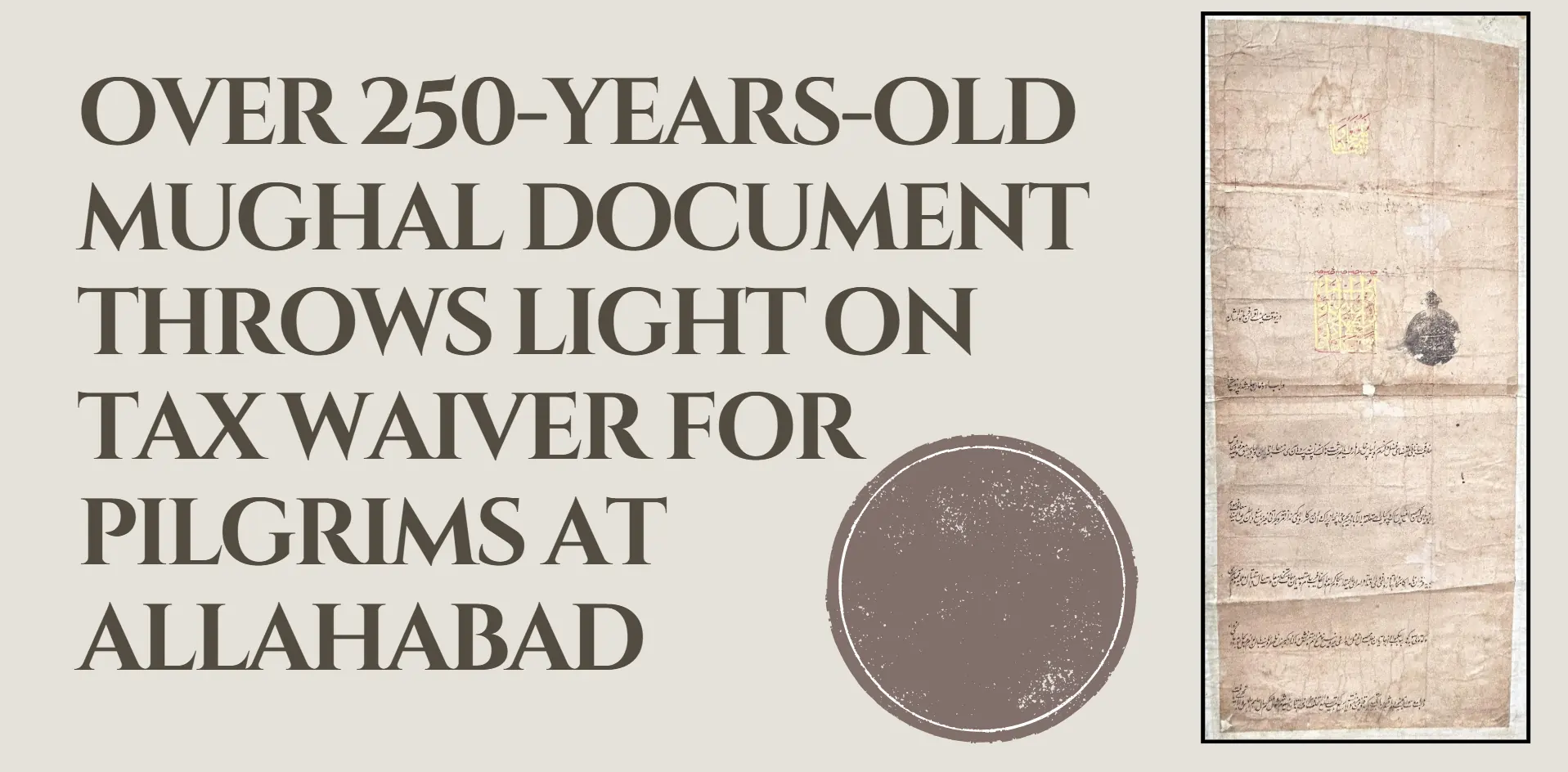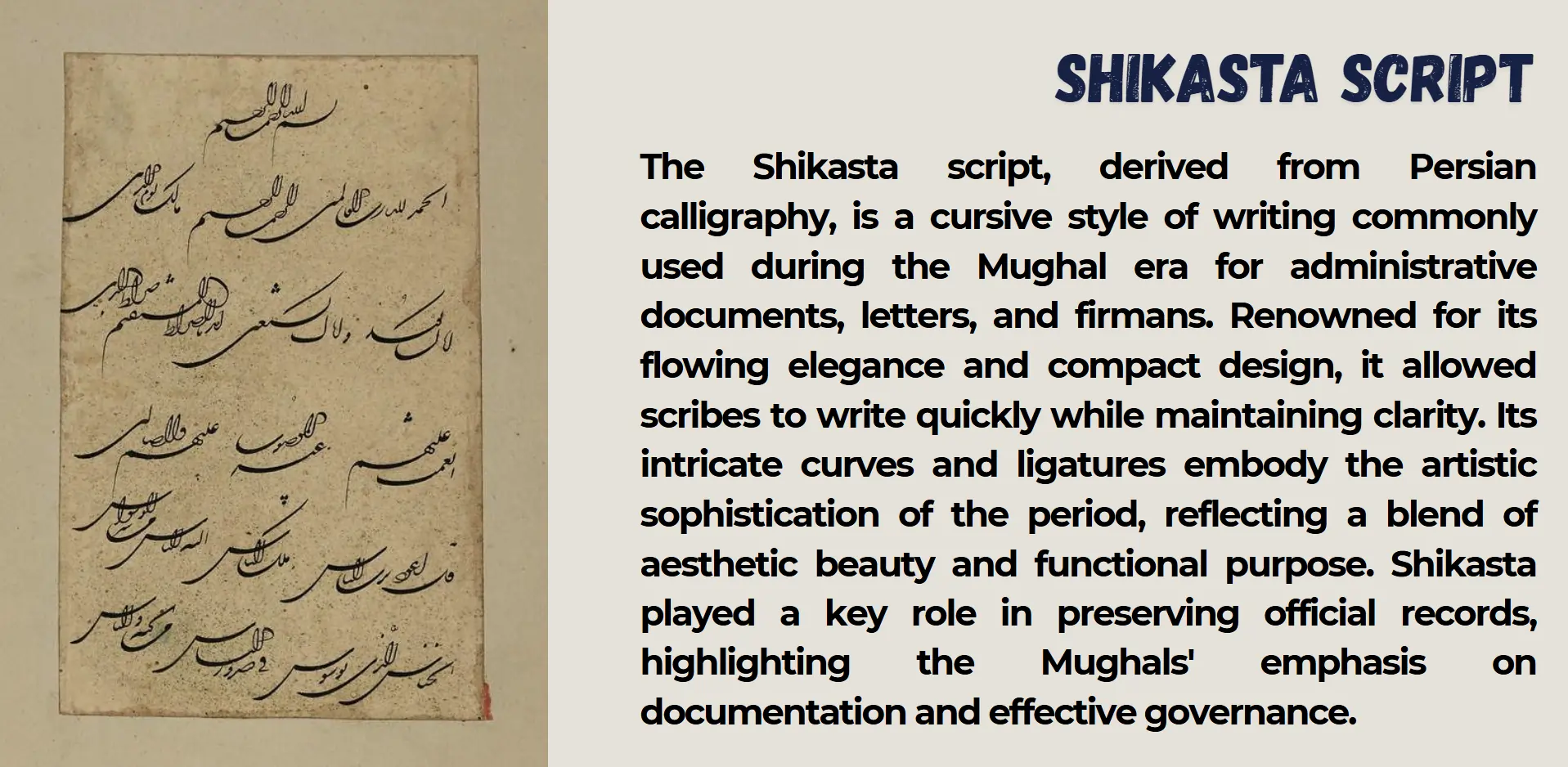The 250-year-old Mughal document named Firman provides historical knowledge about Shah Alam II through Telangana State Archives while demonstrating religious tolerance as well as cultural unity within the empire.

During the time of Mughal Empire administrative competence established a significant position in Indian history. A 250-year-old document exists among the treasures of this collection which reveals important details about Shah Alam II's reign while imperial authority maintained power against political disturbances. The imperial document called firman reveals how the emperor cancelled all tax obligations for pilgrims who went to Allahabad which served as a sacred location of worship for Hindus and Muslims. The Shah Alam II document displays elegant shikasta script alongside the Mughal dynasty genealogical seal which presents an example of how the empire practiced governance and combined religious tolerance while safeguarding cultural unity in difficult periods. The Telangana State Archives and Research Institute keep under its custody this vulnerable yet priceless historical record which shows the detailed recording methods used by the Mughals during their time. Through historical, religious and cultural analysis this article links past perspectives to contemporary views about Indian heritage while studying the Mughal document.
Historical Context of the Mughal Firman on Tax Waiver
During the late eighteenth century the Indian subcontinent underwent massive changes when Mughal Empire power diminished as East India Company began its expansion. During this period of political chaos the Mughal rulers worked to secure their governing authority through acts that maintained their administrative control.
The Reign of Shah Alam II
When Shah Alam II became Mughal Emperor in 1760 the Indian subcontinent experienced an unsettled period of history. Political cleavages together with imperial weakening spread across India because regional powers including the Marathas, the Sikhs, and British East India Company enlarged their sphere of control. During his reign Shah Alam II make substantial attempts to protect both the administration methods and cultural tradition of the Mughal dynasty. An edict from Allahabad demonstrates his leadership dedication to political administration and social peace.
The Socio-Political Landscape
India's complex social and political structure during the 18th century was gauged by regional disputes between kingdoms and the British East India Company. The British East India Company expanded its military power while disrupting Mughal authority across India. Shah Alam II showed his moral leadership by providing tax exemptions to pilgrims during a time when the Mughal Empire steadily lost its political power.
Religious Significance of Allahabad
The town of Allahabad established itself as a vital cultural and religious center under its present name Prayagraj. Due to its position between the three rivers Ganga, Yamuna and Saraswati the holy site became crucial for Hindu pilgrimage worship. The Mughal administration understanding the sacred traditions of different faith groups implemented tax exemptions for pilgrims to preserve religious inclusion in their governance system.
Preservation amidst Decline
The declining military strength of the Mughals did not affect their administration which showed organized documentation systems and impartial judicial practices through firmans. The tax waiver firman combined sophisticated administrative methods with an understanding that India had multiple faiths.
This ancient document provides insight into how a fading empire coped with its struggles along with the goals and administrative methods that existed during its final years. Shah Alam II demonstrated his effort to harmonize administrative power with local cultural understanding at a significant moment in India during this time.
The Firman: A Royal Decree
The royal decree issued by Shah Alam II demonstrates the main administrative principles that guided the Mughal Empire. This document demonstrates the ruler's commitment to retain his power while facing disorders of political nature.
Physical Attributes and Craftsmanship
The royal proclamation represents the pinnacle of Mughal artistic skill along with efficient administrative practices. Shikasta script appears throughout this official correspondence because it was the preferred script for official correspondence at that time. The document followed a readable format meant for preservation and showed Mughal sovereignty through its genealogical seal which brought multiple layers of symbolism. The dynastic heritage inscribed on the seal demonstrates how imperial rule endures across a divided social and political system.

Purpose and Content
The firman requires administrative officers to waive taxes for religious seekers visiting Allahabad to perform their sacred rituals. Through his order Shah Alam II established procedures to give people total freedom to perform religious ceremonies as evidence of his dedication to religious welcome. The act of benevolence met three distinct objectives by meeting religious requirements of a wide range of people alongside strengthening the emperor's reputation as just while winning the loyalty of Guajarati’s and Marathas mentioned in the document.
Translation and Interpretation
Extensive work of translation was needed to reveal the fundamental meaning along with effects embedded within this document. The scholars view this decree as a demonstration of Shah Alam II's understanding concerning the cultural core of his realm. The Mughal administrative style shines through the dignified language and deliberate vocabulary they used. Through this formal proclamation the declining Mughal Empire demonstrated its commitment to maintain justice as well as preservation of cultural customs.
Symbolic and Historical Legacy
The firman exists beyond its administrative role because it reveals the Mughal Empire's policy of tolerance regarding cultural and religious practices. The artifact remains available through Telangana State Archives to provide valuable information about the relationships between authority and governance alongside religion during Shah Alam II's administration.
Through its royal decree the Mughal administration showcased its commitment to keeping peace between social groups while dealing with political obstacles.
Religious Significance of the Mughal Firman
The tax exemption mentioned in the Mughal firman demonstrates India's 18th-century devotion to religious practices thus demonstrating the abundant spiritual expressions of that period.
Allahabad: A Sacred Confluence
Allahabad which today carries the name Prayagraj holds central importance as a Hindu sacred place since millennia ago. The holy meeting point of three holy rivers Ganga, Yamuna and Saraswati at Allahabad makes it host the Kumbh Mela considered the largest religious gathering in the world. Hindus consider taking a holy dip at this sacred space essential because it serves to cleanse one morally and provides release from their former wrongdoings. Allahabad's primary place as a religious center drew the Mughal administration to legally exempt pilgrims from taxation as part of its support for spiritual activities.

Encouraging Religious Harmony
The document specifically targets Gujaratis and Marathas who were significant contributors to the economic life and cultural heritage of the Mughal Empire. Through his tax exemption policies Shah Alam II pursued religious inclusion to build friendly relations between various social communities. Through this policy framework the emperor demonstrated respect for different traditions while building strong emotional ties to his subjects throughout an unstable political period. These gestures represent the Mughals' overall administrative philosophy that accepted India's multicultural nature.
Fostering Pilgrimage and Spiritual Accessibility
The practical benefit of tax exemptions enabled a wide range of society to conduct their religious pilgrimages. The decision from the Mughal emperor enabled more people to participate in religious activities thus strengthening the cultural and spiritual aspects of society. The order implemented Mughal administrative standards by accepting the existence of distinct traditions among people under their rule.
The Mughal Empire showed their knowledge of spiritual development and intercommoned harmony through this royal proclamation.
Preservation and Legacy of the Mughal Firman
The firman released by Shah Alam II about 250 years ago remains a precious artifact which belongs to India. This historical document from past centuries endures strong qualities of cultural value combined with enduring survival.
Efforts by the Telangana State Archives
The Telangana State Archives and Research Institute have established the firman among their collection of preserved artifacts. The institution fulfils its mission to preserve delicate historical documents so researchers from future generations will have them available for study. The institution implements perfect conservation approaches by merging controlled climatic storage with sensitive material handling strategies to prevent damage. The firman exists today because historians and archivists persistently sustained it from paper degradation while keeping its delicate shikasta script safe.

Resilience amid Natural Disasters
Despite severe flood situations the original copy of the firman maintained its resistance to damage. Past caretakers valued this delicate document into existence because of their profound worshipful attitude towards it. Many historical artifacts demonstrate exceptional environmental resistance according to stories about their ability to withstand harsh conditions therefore they need proper protective measures for exposure risks.
Symbol of Mughal Administration
This document joins other historical records from the time to represent the peak achievement of Mughal administrative policies. Mughal rulers established detailed documentation systems which formed an essential part of their governmental operation for practical governance. The stamp at the bottom of the document confirms the dynasty maintained unbroken imperial control throughout all periods of its existence. India ensures the protection of essential objects from its prosperous past through this historical artifact.
Educational and Cultural Importance
The conserved document works as an essential scholarly research tool for academic scholars as well as historians and students. The document presents meaningful information about the administrative practices of Shah Alam II and 18th-century Indian societal patterns. This historical document functions to connect modern times with Mughal Empire heritage thereby establishing a cultural connection between present and past. Through exhibitions and academic discussions together with public shows of artifacts such displays help people establish stronger relationships with their historical past.
The firman serves both to defend a historical artifact and to celebrate the vanished historical period also it advances cultural heritage's long-term preservation. India’s historical story will always emphasize this symbol's vital role throughout multiple future generations.
Cultural and Symbolic Insights of the Mughal Firman
The 250-year-old firman issued by Shah Alam II delivers compelling information about the cultural significance together with symbolic elements that defined the Mughal Empire. Administrative history demonstrates only one aspect of its importance because it embodies important elements of heritage.
The Genealogical Seal and Dynastic Continuity
The Mughal dynastic genealogy stands out prominently as the primary component within the firman document. The Mughals used this royal seal to show how imperial dynasty continues despite historical events. The seal's prime location on display under Shah Alam II's rule represented both the emperor's power along with his dynasty's stay of legitimacy despite Mughal empire degradation. The seal contained ancestral names which demonstrated both authentication and historic importance of the dynasty.
Religious Tolerance as a Governance Principle
Pilgrims received tax exemptions through the firman because the Mughals purposefully demonstrated their acceptance for various faiths. At Allahabad Mughal governance supported Hindu traditions to demonstrate its government policies of acceptance. Through these gestures the empire demonstrated its position as an integrative entity among different groups within its multicultural society. The policy strengthened social unity by providing non-financial protection to religious practices. This firman serves as proof that the Later Mughal Empire dedicated its efforts toward sustaining religious co-existence between multiple faith groups.
The Role in Cultural Legacy
This firman demonstrates how Mughals required complete documentation of their policies to demonstrate their commitment to accountability and fairness in their administration. The practice of issuing firman went beyond administrative procedures since it established a cultural link between rulers and their people. The Mughal Empire demonstrated its intellectual plus organizational excellence through this documentation system which established a lasting impact on Indian administrative practices.
A Window into 18th-Century Society
The document provides essential knowledge about the social customs of 18th-Century Indian culture. This document shows how administrators used religious knowledge to unite secular authority and achieve balanced governance.
As a cultural link between ancient India and modern-day understanding of national multiplicity the royal decree stands as a historic artifact of enduring significance.
Conclusion
Shah Alam II’s Mughal firman dating from 250 years ago showcase the magnificent legacy of Mughal rule and its principled governance system which safeguarded social harmony between communities. The historical document spans time because its preservation tells us precise imperial operations and how India respected its diversity during its original era. Historical artifacts which survive serve as evidence to defend our approach to protecting historical heritage documents because they preserve shared historical sources of information. Through this historic document India retains vital access to its diverse cultural legacy from a period of spiritual and social resilience.